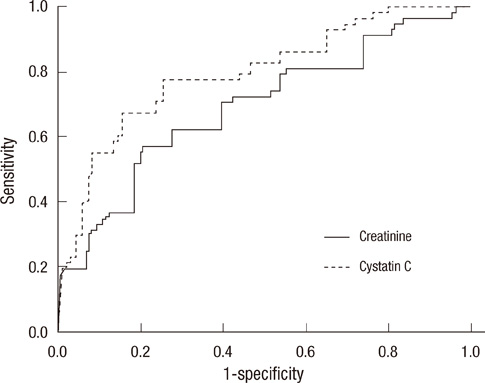J Korean Med Sci.
2012 Jul;27(7):784-787. 10.3346/jkms.2012.27.7.784.
Spot Urine Albumin to Creatinine Ratio and Serum Cystatin C are Effective for Detection of Diabetic Nephropathy in Childhood Diabetic Patients
- Affiliations
-
- 1Department of Pediatrics, Yonsei University College of Medicine, Seoul, Korea.
- 2Department of Pediatrics, Sowha Children's Hospital, Seoul, Korea. dhkim3@yuhs.ac
- KMID: 2157924
- DOI: http://doi.org/10.3346/jkms.2012.27.7.784
Abstract
- Spot urinary albumin to creatinine ratio (ACR) measurement has been suggested as a surrogate to 24-hr urine collection for the assessment of microalbuminuria, and cystatin C (cysC) is known as an advantageous marker for renal function. The aim of this study was to evaluate the clinical values of spot urinary ACR and serum cysC for the assessment of diabetic nephropathy instead of 24-hr urine microalbumin in children and adolescents with diabetes. A total of 113 children and adolescents (age 12-19 yr, M:F = 47:66) with type 1 or 2 diabetes were enrolled. We evaluated the validity of spot urine ACR and serum cysC, and then compared them to 24-hr urine microalbumin and creatinine clearance. Spot urine ACR was correlated with 24-hr urine albumin excretion (R2 = 0.828, P = 0.001) and creatinine clearance (R2 = 0.249, P = 0.017). The ROC curve analysis of serum cysC demonstrated higher diagnostic accuracy than that of serum creatinine (AUC 0.732 vs 0.615). Both the measurements of spot urine ACR and serum cysC might better predict the presence of diabetic nephropathy than 24-hr urine microalbumin in childhood diabetic patients.
MeSH Terms
-
Adolescent
Albuminuria/*urine
Child
Creatinine/*urine
Cystatin C/*blood
Diabetes Mellitus, Type 1/*diagnosis
Diabetes Mellitus, Type 2/*diagnosis
Diabetic Nephropathies/*diagnosis
Female
Glomerular Filtration Rate
Hemoglobin A, Glycosylated/analysis
Humans
Kidney Function Tests
Male
Predictive Value of Tests
ROC Curve
Cystatin C
Hemoglobin A, Glycosylated
Creatinine
Figure
Cited by 1 articles
-
Measurement of urinary protein in children
Myung Hyun Cho
Child Kidney Dis. 2022;26(2):69-73. doi: 10.3339/ckd.22.030.
Reference
-
1. Rossing P. Diabetic nephropathy: worldwide epidemic and effects of current treatment on natural history. Curr Diab Rep. 2006. 6:479–483.2. Bangstad HJ, Osterby R, Dahl-Jørgensen K, Berg KJ, Hartmann A, Nyberg G, Frahm Bjørn S, Hanssen KF. Early glomerulopathy is present in young, type 1 (insulin-dependent) diabetic patients with microalbuminuria. Diabetologia. 1993. 36:523–529.3. Perkins BA, Ficociello LH, Ostrander BE, Silva KH, Weinberg J, Warram JH, Krolewski AS. Microalbuminuria and the risk for early progressive renal function decline in type 1 diabetes. J Am Soc Nephrol. 2007. 18:1353–1361.4. Phillipou G, Phillips PJ. Variability of urinary albumin excretion in patients with microalbuminuria. Diabetes Care. 1994. 17:425–427.5. Eshøj O, Feldt-Rasmussen B, Larsen ML, Mogensen EF. Comparison of overnight, morning and 24-hour urine collections in the assessment of diabetic microalbuminuria. Diabet Med. 1987. 4:531–533.6. Levey AS, Coresh J, Balk E, Kausz AT, Levin A, Steffes MW, Hogg RJ, Perrone RD, Lau J, Eknoyan G. National Kidney Foundation practice guidelines for chronic kidney disease: evaluation, classification, and stratification. Ann Intern Med. 2003. 139:137–147.7. Assadi FK. Quantitation of microalbuminuria using random urine samples. Pediatr Nephrol. 2002. 17:107–110.8. Aksun SA, Ozmen D, Ozmen B, Parildar Z, Mutaf I, Turgan N, Habif S, Kumanlioğluc K, Bayindir O. Beta2-microglobulin and cystatin C in type 2 diabetes: assessment of diabetic nephropathy. Exp Clin Endocrinol Diabetes. 2004. 112:195–200.9. Newman DJ, Thakkar H, Edwards RG, Wilkie M, White T, Grubb AO, Price CP. Serum cystatin C: a replacement for creatinine as a biochemical marker of GFR. Kidney Int Suppl. 1994. 47:S20–S21.10. Schwartz GJ, Haycock GB, Edelmann CM Jr, Spitzer A. A simple estimate of glomerular filtration rate in children derived from body length and plasma creatinine. Pediatrics. 1976. 58:259–263.11. Macisaac RJ, Tsalamandris C, Thomas MC, Premaratne E, Panagiotopoulos S, Smith TJ, Poon A, Jenkins MA, Ratnaike SI, Power DA, et al. Estimating glomerular filtration rate in diabetes: a comparison of cystatin-C- and creatinine-based methods. Diabetologia. 2006. 49:1686–1689.12. Schmitz A, Vaeth M, Mogensen CE. Systolic blood pressure relates to the rate of progression of albuminuria in NIDDM. Diabetologia. 1994. 37:1251–1258.13. Jensen JS, Clausen P, Borch-Johnsen K, Jensen G, Feldt-Rasmussen B. Detecting microalbuminuria by urinary albumin/creatinine concentration ratio. Nephrol Dial Transplant. 1997. 12:6–9.14. Keane WF, Eknoyan G. Proteinuria, albuminuria, risk, assessment, detection, elimination (PARADE): a position paper of the National Kidney Foundation. Am J Kidney Dis. 1999. 33:1004–1010.15. Donahue RP, Stranges S, Rejman K, Rafalson LB, Dmochowski J, Trevisan M. Elevated cystatin C concentration and progression to pre-diabetes: the Western New York study. Diabetes Care. 2007. 30:1724–1729.16. Coll E, Botey A, Alvarez L, Poch E, Quintó L, Saurina A, Vera M, Piera C, Darnell A. Serum cystatin C as a new marker for noninvasive estimation of glomerular filtration rate and as a marker for early renal impairment. Am J Kidney Dis. 2000. 36:29–34.17. Chae HW, Shin JI, Kim BS, Kim HS, Kim DH. Effectiveness of serum cystatin C and β2-microglobulin as early predictive markers of diabetic nephropathy. J Korean Soc Pediatr Endocrinol. 2008. 13:177–183.18. Tan GD, Lewis AV, James TJ, Altmann P, Taylor RP, Levy JC. Clinical usefulness of cystatin C for the estimation of glomerular filtration rate in type 1 diabetes: reproducibility and accuracy compared with standard measures and iohexol clearance. Diabetes Care. 2002. 25:2004–2009.19. Schwartz GJ, Muñoz A, Schneider MF, Mak RH, Kaskel F, Warady BA, Furth SL. New equations to estimate GFR in children with CKD. J Am Soc Nephrol. 2009. 20:629–637.20. Xia LH, Bing XG, An XT. Serum cystatin C assay for the detection of early renal impairment in diabetic patients. J Clin Lab Anal. 2004. 18:31–35.
- Full Text Links
- Actions
-
Cited
- CITED
-
- Close
- Share
- Similar articles
-
- Effectiveness of Serum Cystatin C and beta2-microglobulin as early Predictive Markers of Diabetic Nephropathy
- Lack of Association between Serum Cystatin C Levels and Coronary Artery Disease in Diabetic Patients
- Usefulness of Serum Cystatin C for the Evaluation of Renal Function in Diabetic Patient
- Cystatin C as an Early Biomarker of Nephropathy in Patients with Type 2 Diabetes
- Is Serum Cystatin-C a Useful Marker Predicting the Initiation of Maintenance Dialysis?



